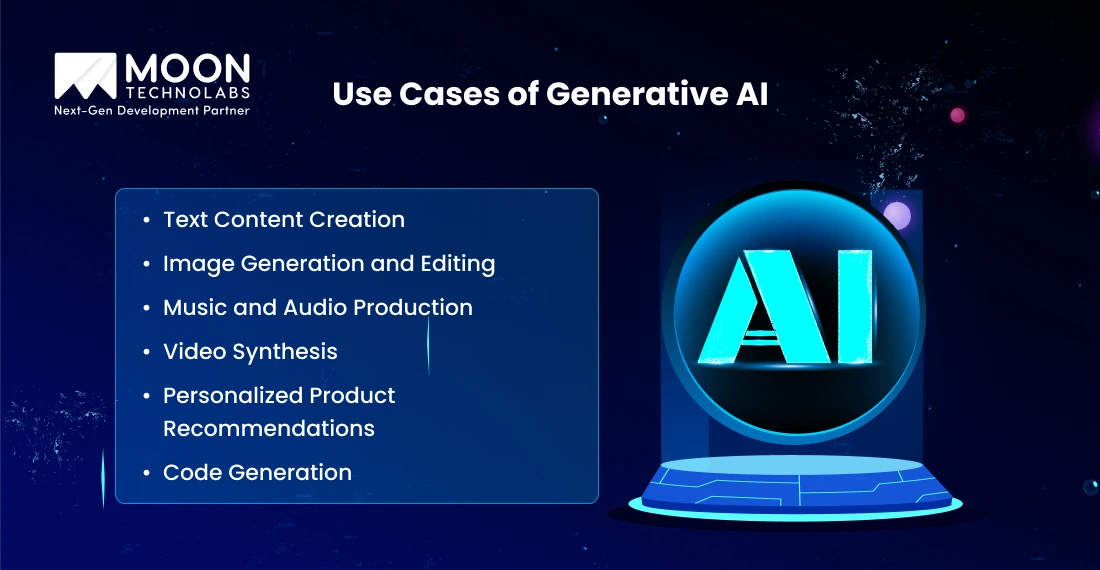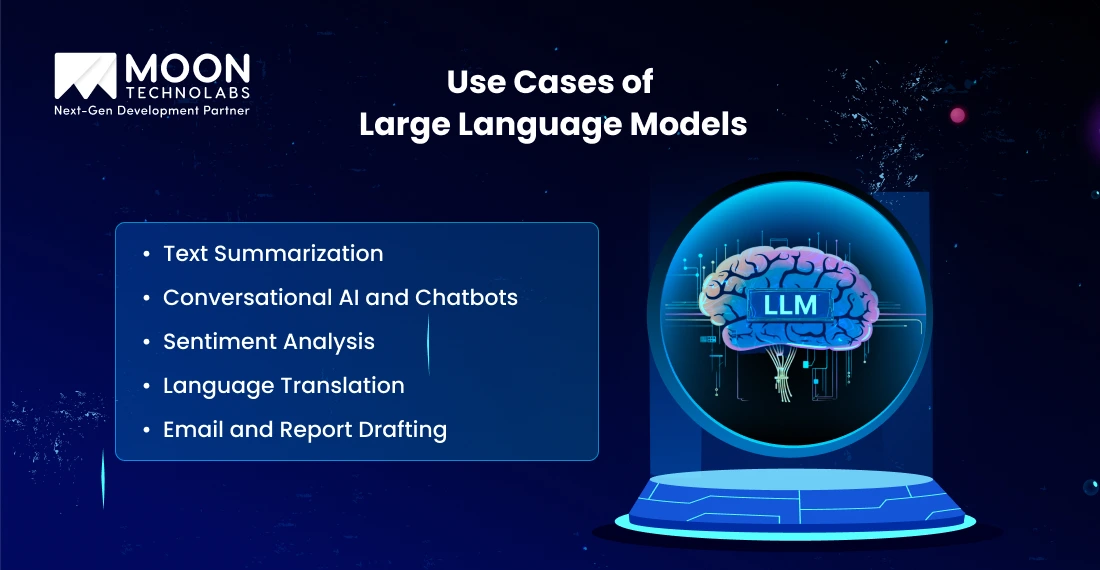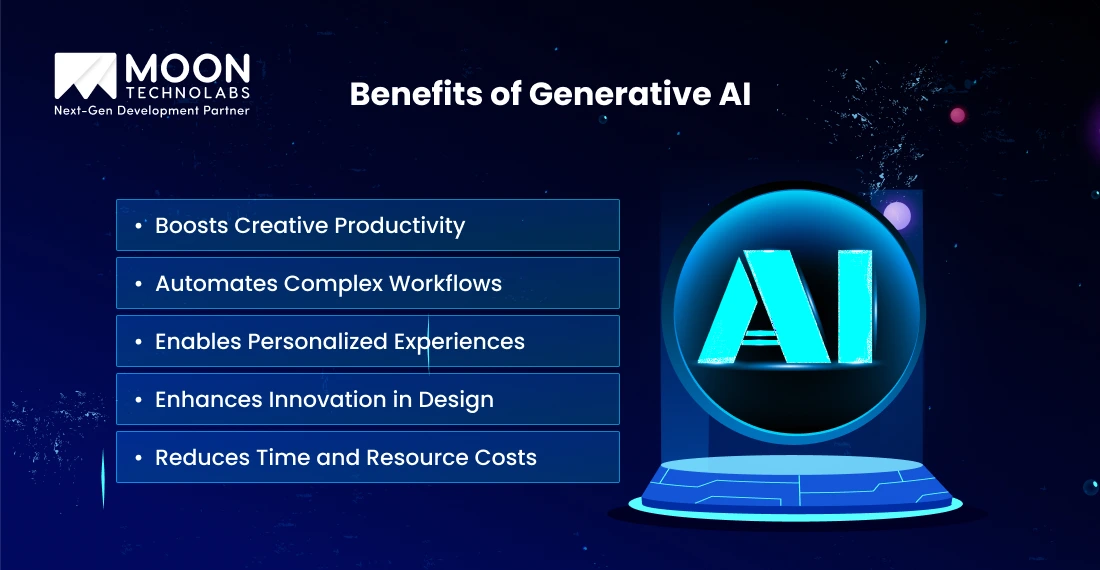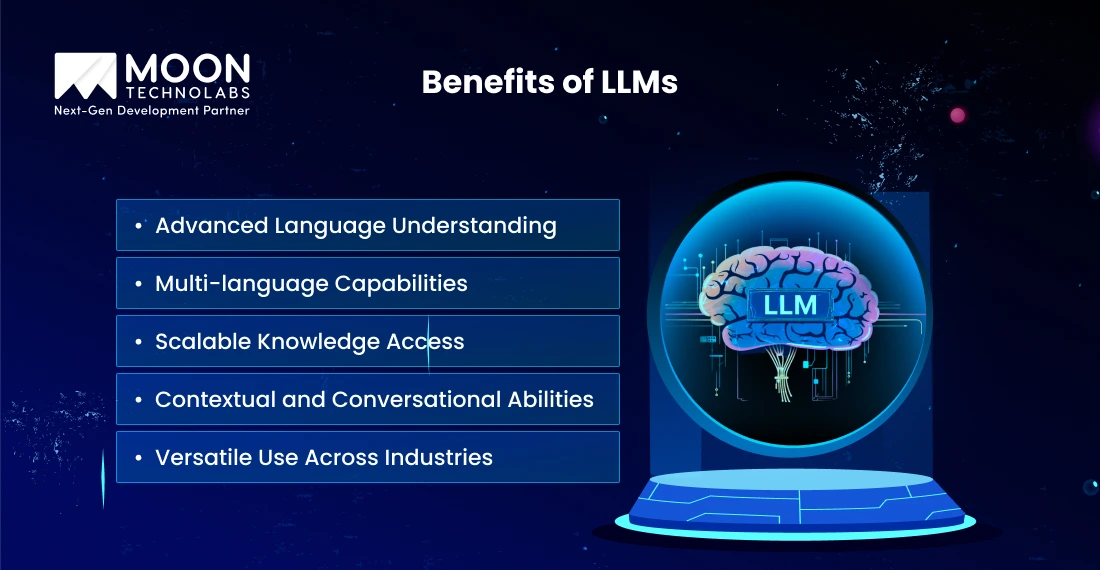Table of Content
Table of Content
Have you heard people talking in AI jargon, using Generative AI and LLM interchangeably? While it is easy to get confused between them, you must know that they are not the same. Mixing them up can cost your business when choosing the technology or planning your future scope.
It is crucial to understand how each function and the overlaps that exist. In this article, you will learn what each term means and how it functions. You will also learn why they matter so that you can make the right choice, ensuring it is aligned with your business needs.
Generative AI is the art; Large Language Models are the brushstrokes behind it. 🎨📚
Using Generative AI, you can create diverse content types, such as text, images, code, and music. In this case, the models will dive deep into the existing data set to build patterns that can generate this content.
Basically, you get a smart assistant that would process the information available to create something new and unique for you. Exampls of Generative AI include DALL E, which uses text prompts to create original images. ChatGPT is another example that gives you poems, emails and prose from the ext prompts.
This AI type can mimic humans to create realistic and relevant outputs for your needs.
Large Language Models (LLMs) are trained AI models that can understand, interpret, and general human language. They use large data volumes, including text data to understand the grammar, context, and meaning.
As this model is developed using large number of parameters that are then used to make predictions and forecasting, it is called large.
As they analyze large number of data, they become the brains behind your AI tools, and provide content that is fluent and contextually aware.
Generative AI can help you create new content like images, text and music while Large Language Models focus on understanding and interpreting the human language using large data volumes especially text data.
Generative AI can help you create diverse outputs, ranging from text and images to audio and video. On the other hand, LLM prioritizes creating and interpreting human language, like text-based content like summaries and translations. This means LLM specializes in high-quality language creation while Generative AI offers broader capabilities.
Generative AI uses diverse architectures like GANs, VAEs and transformers; it depends on the type of content like image, audio and text.
LLMs, on the other hand, uses the transformer-driven architecture that you can use to predict the sequence and understand the language.
You can use Generative AI in diverse industries like gaming, art, music, marketing and simulation to provide versatile solutions that go beyond language. LLM can be used for customer service, content automation and education that depend on text-based interactions.
To get generative AI outcomes, you need large and multi-modal datasets. They use datasets that are customized to the content type you aim to produce.
This model is trained to analyze books, articles and web content to comprehend language and generate the content. LLMs are specifically tuned for language while Generative AI can interpret large data sets to generate multi-format outputs.
The Generative AI models can produce diverse content formats and are adaptable to different creative tasks or domains. LLM is tuned for text and is considered excellent for language-specific tasks like translation and summarization.
Generative AI is more flexible, while LLM offers deeper specialization when text-specific outcomes are needed.
Generative AI supports multiple modalities like text, images and audio, based on the model type. It is used in most cases as it uses cross-modal capabilities. LLM supports only text modality.
While there are newer models that integrate images, they prioritize language processing. Gen AI can support rich outputs, which means it is useful for multi-modal applications.
You get creative outputs like art, stories and visuals as the Gen AI model leans towards creativity. LLM leans towards the analytical side, summarizing and interpreting the language, thus ensuring it can help with structured and informative tasks.
Basically, Gen AI is used for creative tasks while LLM is used for logic and precision.
The core components of Gen AI and LLM comprise neural networks, advanced algorithms and large-scale training datasets. It can help with pattern recognition and content generation. You can ensure these models adapt to the specific tasks by fine-tuning them and using prompt engineering.
Both Gen AI and LLM use transformer models, making them the backbone of your AI system. Using self-attention mechanism, they are able to process the sequential data for contextual awareness and long-text generation.
Transformers offer scalable parallel training that is effective for language generation and translation.
There are two neural networks in GAN, the generator and the discriminator. It is locked together, wherein the generator produces image data while the discriminator assesses the authenticity of the content produced.
The adversarial networks make the generator deliver realistic content, which is why GAN is used in AI models for image synthesis and style transfer.
This component is used to reverse the noise process, which helps transform the random outputs into more coherent versions. Using these components, DALL E 2 and Stable Diffusion are able to deliver high-quality images. As this component can make every detail, it is used in generating visual content.
LLMs are trained using vast datasets, using which they understand and generate human-like language. This component or model can actively perform tasks like translation, dialogue creation and summarization. This model can be used to develop chatbots, virtual assistants and content-generation tools.
By combining the input from diverse formats like text, images, and audio, AI understands and generates for diverse modalities. You can integrate vision language models with sensor fusion techniques to create image captioning and video summaries.
This component can help bridge the gap that exists between human communication and machine interpretation.
You Might Also Like:

Here are all the major use cases of Generative AI to deliver personalized recommendations and synthetic media generation.
Generative AI is used to create blogs, emails and product descriptions within seconds. By understanding the tone, context and structure, you can create content faster and easier. As a result, it is best for marketers and businesses that need relevant and unique copy.
AI can easily generate the picture using a few text prompts. There are tools like DALL E that allow you to create and edit images using single prompts, which can be useful for designers and advertisers who want to bring alive their ideas.
Gen AI makes music creation accessible by producing diverse types, such as background scores and original tracks. Your musicians and content creators can experiment with different styles and inspirations. In fact, even non-musicians can create audio with a few prompts.
Using AI, you can create short clips, animate your characters, and even produce deepfakes. It is best used for filmmaking and gaming and helps speed up production while enhancing visuals. However, it can raise questions about ethics in India.
With Generative AI, you get tailored product suggestions that meet unique user preferences, behaviour, and context. They become your shopper, who can help you choose what you want to boost engagement and deliver customized experiences.
If you need help with coding, you can use Gen AI tools like GitHub Copilot. It can write the functions and offer fixes. In fact, you can even generate the entire program, making it a game changer for developers to save time and reduce errors.

The major use cases of large language models, such as text generation and question answering to support different tasks like code completion.
LLMs can be used to read through long articles and documents to create clear and concise summaries within seconds. If you are a busy professional or researcher, you get summarized content without spending hours reading.
With LLM, you can make your chatbots understand what users are saying and respond in a human way. It can be used for customer support or as a virtual assistant, as they can handle large amounts of queries and solve problems while ensuring helpful and casual interactions.
If you want to know how your users feel about the brand and its service, you should go with LLM. It can analyze the text to detect emotions, thus understanding if the sentiment is positive or neutral. It helps fine-tune your messaging and customer service strategy.
If you want to translate a text from one language to another with fluency and precision, you can use LLM. It is used in apps that process in real-time or are focused on global communication. Using LLM, you can close the language gaps that exist.
LLMs can easily streamline the process of writing emails or drafting reports to make it effortless. You can get well-structured messages and summaries using prompts and raw notes that contain clarity and proper tone.
LLMs are great at giving out facts after analyzing large documents and databases. You will get precise answers from this model, which is why they are useful for research and customer support.
You Might Also Like:

Gen AI furthers your productivity and creativity by automating content generation and offering personalization.
Whether you need content creation ideas or help with translating your ideas into designs, Gen AI can become your creative co-pilot. It ensures you never need to start from scratch.
You can use this model to manage tedious tasks efficiently. It shifts your focus and energies from manual code creation and report generation to strategy and core business functions.
The Gen AI model can cater to recommendations and content that is relevant to the user by considering their preferences. It is used to improve user engagement and satisfaction.
This model allows designers to experiment with their concepts as they can get instant results for their layout, colour scheme and prototype ideas. You can use this model for rapid iteration as well.
Creating content or producing a visual from scratch can be expensive and time-consuming. You can reduce the time and money spent on large teams by using Gen AI for your ideas.

Large Language Models, LLMs, can help improve communication and decision-making for your business to acquire information effortlessly or translate languages.
LLMs can easily interpret the tone, nuance, context, and grammar of the language as a human would. You can use it to interpret complex communication or analyze documents and summarize them for different audiences.
Whether you want to write in a different language or translate your text to another language, you can do so using LLM. It is the best fit for businesses that handle international communication, as it breaks the communication barriers.
If you want fast, concise, and accurate responses to your queries, LLMs are your go-to model. They can analyze vast data sets and extract the exact information to meet your needs.
Whether you want to maintain the conversational flow or offer contextual responses, you must use LLM. They can help manage smooth and intuitive communications that are crucial in use cases like chatbots and virtual assistants.
It can act as a problem solver for diverse industries, ranging from healthcare to finance. It helps write reports, analyze the feedback and offer customer support, making it valuable for all industries.
Both Generative AI and Large Language Models (LLM) share overlapping yet distinct purposes. While Gen AI offers it solutions to a broad category, such as models that can produce diverse content types, LLM focuses on understanding and responding to specific human language.
If you want a language-centric task like writing or summarizing, you must use the LLM model. However, if you want to use it for multi-modal purposes like image generation, you must use Gen AI.
We help you choose and implement the right AI approach—Generative AI or LLM—based on your project needs.
Ever wondered how an AI model can offer diverse functions, such as writing poems, generating designs or chatting like a human being? There are two completely unique models available in the AI landscape, Generative AI and Large Language Models.
One offers broad and multimodal solutions while the other specializes in language-specific needs. Before you choose the AI tool, you must understand the basic differences between these models. It is equally crucial to choose an AI system that supports your goal.
If you want to build a smart and efficient model, it’s time to look for the right AI model for your business.
01
02
03
04
05
Submitting the form below will ensure a prompt response from us.